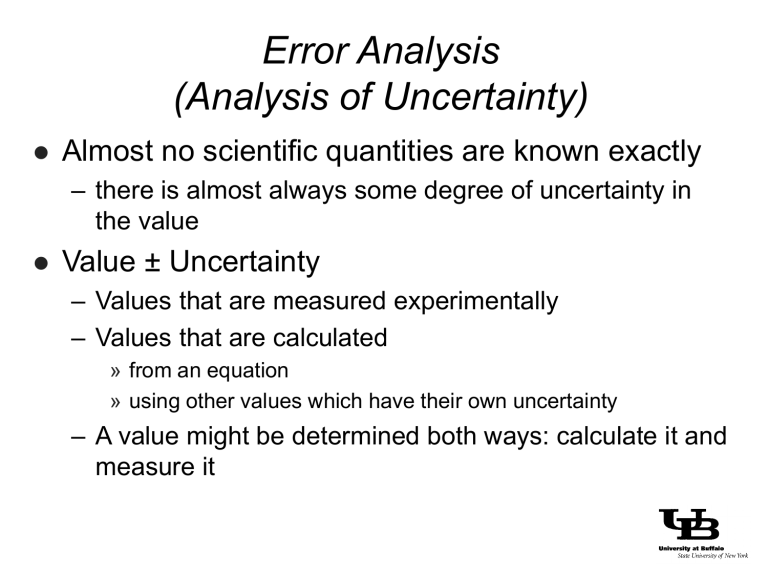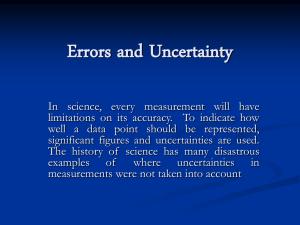Error Analysis (Analysis of Uncertainty)

Error Analysis
(Analysis of Uncertainty)
Almost no scientific quantities are known exactly
– there is almost always some degree of uncertainty in the value
Value ± Uncertainty
– Values that are measured experimentally
– Values that are calculated
» from an equation
» using other values which have their own uncertainty
– A value might be determined both ways: calculate it and measure it
Uncertainty in Measured Values
Two components of Uncertainty
– Measured value ± systematic errors ± random errors
Precision of a measurement
– variations due to random fluctuations
– power supply, angle of view of a meter, etc.
Accuracy of a measurement
– includes uncertainty in precision
– also includes systematic errors
» incorrect experimental procedure, uncalibrated instrument, use a ruler with only 9 mm per cm
Add four bullseyes here next time
Treatment of Random Errors
Assume that systematic errors have been eliminated
Simple Estimate
– Analog Gauge or Scale
» How finely divided is the readout, and how much more finely do you estimate that you can interpolate between those divisions?
– Digital Readout
» What is the smallest stable digit?
Statistical Treatment of Random Errors
Suppose you repeated the exact same measurement at the exact same conditions an infinite number of times
– Not every measurement will be the same due to random errors
– Instead there will be a distribution of measured values
Could use the results to construct a frequency distribution or probability function
Frequency Distribution or
Probability Function
60
50
40
30
20
10
0
23
.5
25
.5
27
.5
29
.5
31
.5
33
.5
35
.5
37
Measured Value (+/- 0.5)
.5
39
.5
0.12
0.1
0.08
0.06
0.04
0.02
0
23
.5
25
.5
27
.5
29
.5
31
.5
33
.5
35
.5
Measured Value
37
.5
39
.5
41
.5
With a finite number of measurements you get a frequency distribution
– Probability of a measurement falling within a given box is number in that box divided by total number
With an infinite number you get a probability function
– Plot of P(x) versus x
– P(x) is the probability of a measurement being between x and x + dx
Characteristics of the Probability
Function
Certain kinds of experiments may naturally lead to a certain kind of probability function
– For example, counting radioactive decay processes leads to a
Poisson Distribution
Often, however, it is assumed that the errors are by a
Normal Distribution Function
1 M x
2
exp
2
2 N
– is the mean (average) of the infinite number of measurements
– is the standard deviation of the infinite number of measurements
Use of the Probability Function
z
F
H
I
K
1
P(xµ) is normalized:
– That is, the total area under the P curve equals 1.0
If you knew
and
(and so you knew P) you could find the limits between which 95% of all measurements lie.
Insert plot with shaded area at left
– Noting that P is symmetric about µ you could say with 95% confidence that the measured value lies between
-
and
+
– That is, the value is ± at the
95% confidence level
An Infinite Number of Measurements
Isn’t Practical
You can only make a finite number of measurements
– Therefore you do not know or
You can calculate the average and variance for your set of measurements x
1
N i
N
1 x i
S
2
N
1
1 i
N
1
Average and Variance of the Data Set
Do Not Equal
and
Use Student’s t-Table to relate the two:
– Pick a confidence level, 95%
– Define degrees of freedom as N-1
– Read value of t
» Be careful, t-Tables can be presented in two ways
» One is such that 95% will be less than t
In this case if you want 95% between -t and t you need 97.5% less that t
(the curves are symmetric)
» Another is such that 95% will be between -t and t
Uncertainty limits are then found from the variance
– value = average of the data set ±
tS
N
One Form of Student’s t-Table
Add shaded bell curve here
The value of t from this form of the table corresponds to 95% of all measurements being less than
+
and therefore 5% being greater than
+
Note that if you want 95% of all measured values to fall between
-
and
+
– then 97.5% of all measured values must be less than
+
(or 2.5% will be greater than
+
)
– and then due to the symmetry of P
97.5% will also be greater than
-
(or another 2.5% will be less than
-
)
– so 95% will be between
-
and
+
Add abbreviated t-table here
Another Form of Student’s t-Table
Add shaded bell curve here
The value of t from this form of the table corresponds to 95% of all measurements being between
-
and
+
Therefore 5% are either
– greater than
+
– or less than
-
Add abbreviated t-table here
Example
Add Problem Statement here
– preferably use data from one of the experiments they are doing
Solution
Add solution here
Summary: Uncertainty in Measured
Quantities
Measured values are not exact
Uncertainty must be estimated
– simple method is based upon the size of the gauge’s gradations and your estimate of how much more you can reliably interpolate
– statistical method uses several repeated measurements
» calculate the average and the variance
» choose a confidence level (95% recommended)
» use t-table to find uncertainty limits
Next lecture
– Uncertainty in calculated values
» when you use a measured value in a calculation, how does the uncertainty propagate through the calculation
– Uncertainty in values from graphs and tables








